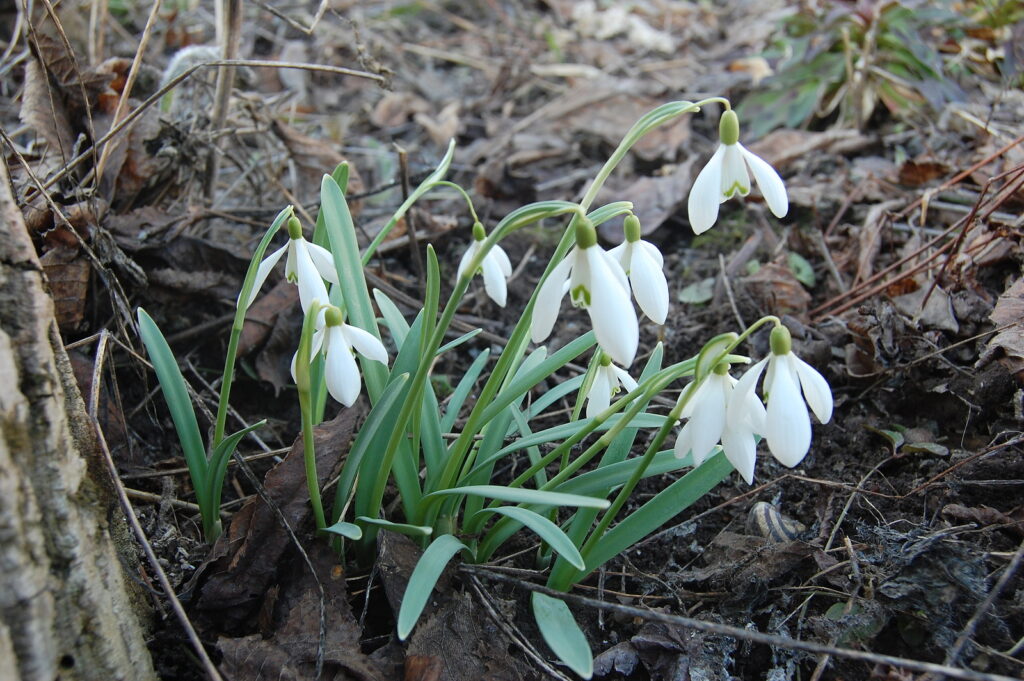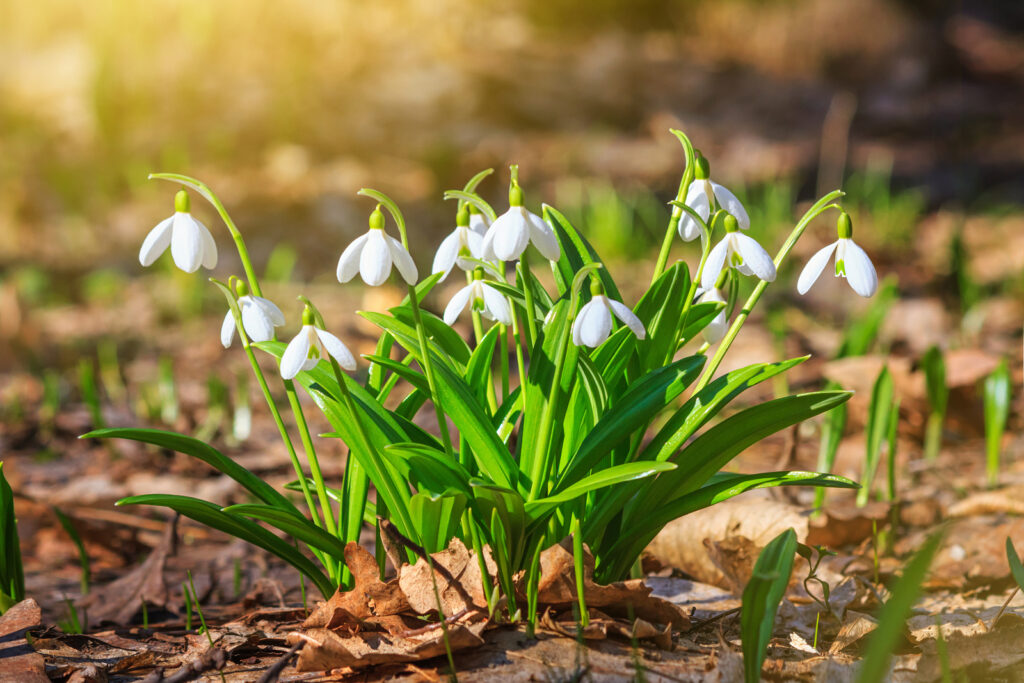Snowdrops, Galanthus, is a perennial bulb with grass-like green foliage and nodding white bell-shaped flowers. Snowdrops bloom in late winter and early spring. They are one of the earliest blooming plants each year.
There are about 19 species of Galanthus. All are hardy perennials.
Each bulb produces a single pendant bloom on an arching stem. The flowers have six petal-like tepals; the three outer tepals are teardrop-shaped and larger than the inner three. Flowers may be all white or green and white.
Plant snowdrops with other early-flowering bulbs and violas in late winter or early spring beds or in containers.
Snowdrop bulbs are poisonous and contact with the foliage can cause skin irritations.
Snowdrops, Galanthus, are sometimes confused with a close relative, Leocojum is commonly called snowflakes. Leucojum bears one to eight flowers per stem and have six tepals of equal size.

Get to know Galanthus – Snowdrop
- Plant type: Hardy late winter or early spring-blooming bulb
- Growing Zones and range: Grows best in Zones 3 to 7 also in the Pacific Northwest
- Hardiness: Half-hardy; withstands heat and cold
- Height and width: 4 to 8 inches (10-20cm) tall, 3 to 6 inches (7.6-15cm) wide
- Flowers: Nodding, bell-like white flowers; flowers are solitary and pendant about 1 inch wide with lilylike outer petals that open more on warm days.
- Bloom time: Late winter or early spring; bloooms ahead of crocus
- Uses: Woodland gardens; can be naturalized in lawns
- Botanical name: Galanthus nivalis
- Common name: Snowdrop
Where to plant Galanthus – Snowdrop
- Plant snowdrops in full sun or light shade.
- Grow snowdrops in humus-rich, well-drained soil that is moist.
- Snowdrops prefer a soil pH of 6.5 to 7.5.

When to plant Galanthus – Snowdrop
- Plant snowdrop bulbs in mid-autumn.
- Sow seeds outdoors in late spring; seedlings take 2 to 3 years to bloom.
Planting and spacing Galanthus – Snowdrop
- Prepare the soil ahead of planting snowdrops by raking in fertilizer, compost, and bonemeal.
- Sow seeds 2 inches (5cm) apart and 1/8 inch deep.
- Plant bulbs outdoors 3 inches (7.6cm) deep.
- Space snowdrops 3 to 6 inches (7.6-15cm) deep. Plants produce offsets and self-sown seedlings and will form a large clump in a season or two.
- Plant snowdrops in groups of 10 or more for best effect.

How to water and feed Galanthus – Snowdrop
- Snowdrops need moderate water; keep the soil evenly moist. Water whenever the soil starts to dry out.
- Fertilize snowdrops lightly at planting time with a slow-release all-pure fertilizer.
- Fertilize after the plants bloom each year.
Galanthus – Snowdrop care
- Protect bulbs in winter in very cold regions by mulching lightly with 3 inches of pine needles or chopped leaves. Remove the mulch in states as winter comes to an end so that shoots can emerge.
- Clumps can be left undisturbed for years; when they become too crowded they will bush bulbs to the surface; that’s when clumps should be divided.
- Snowdrops are usually pest and disease-free.

Galanthus – Snowdrop propagation
- Lift and divide clumps of bulbs after flowering but before the leaves begin to die down. Dig deeply and then gently pull clumps apart to minimize breakage. Replant divided bulbs immediately.
- Sow the seed of species as soon as they are ripe.
Galanthus – Snowdrop species and cultivars.
- Galanthus caucasicus. Species blooms late fall to early spring; bears 1-inch white flowers with inner tepals dipped in green; grows 4 to 6 inches (10-15cm) tall.
- G. elwesii, giant snowdrop. Grows 5 to 9 inches (12.7-23cm) tall; bears fragrant white blooms to 1 inch long.
- G. x grandiflorus. Large-flowered type with leaves up to 10 inches (25cm) long; pendant 1-inch flowers are white.
- G. ikariae. Grows 4 to 6 inches (10-15cm) tall; bears long white flowers with green markings on the inner tepals; blooms from late winter to early spring.
- G. nivalis, common snowdrop. Grow 4 to 5 inches (10-12.7cm) tall with single white flowers, each with green dots on the central petals; flowers are less than an inch long. Cultivars include ‘Viridapicis’ has green tips on both the inner and outer petals; ‘Flore Pleno’ has a double flower with bunched inner petals tipped with lime green.
- G. plicatus. Grows to 8 inches (20cm) tall, white flowers with green mark on the tip of each inner tepal.















